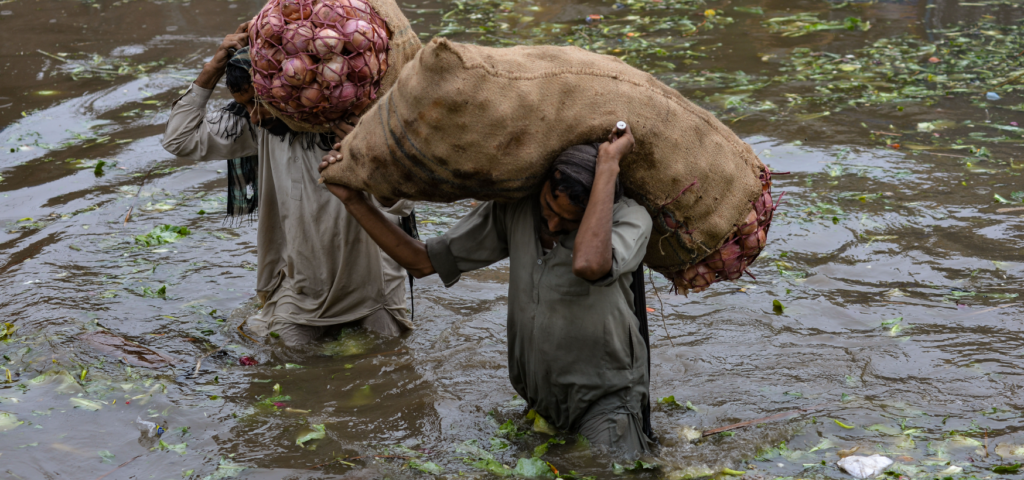Can millions of smallholder farmers meaningfully mitigate climate change and be rewarded for it? We think so.
- November 10, 2022
- 10 minutes read
PxD is collaborating with the Institute for Governance and Sustainable Development (IGSD) to identify opportunities to benefit poor farming communities through their participation in climate mitigation activities.

The 27th Conference of the Parties (COP 27) to the United Nations Framework Convention on Climate Change, is currently taking place in Sharm El-Sheikh, Egypt. COP27 has been dubbed the “African COP” due to its location as well as its strong focus on food systems and agriculture, both of which present pressing climate-related challenges for the continent and many other Global South geographies.
The adoption of improved inputs, new technologies, and practices enabled the agriculture sector to build many ladders for smallholder farmers to climb out of poverty, particularly following the Green Revolution. As yields have increased and farmers produce more than their families consume, selling surplus production has progressively increased farming families’ incomes, reduced the incidence of famine, and improved global food security.
Yet, from drought in the Horn of Africa to the 100-year flood in Pakistan, climate change is devastating smallholder livelihoods. Among its many pernicious effects, a warming climate will accelerate desertification and the incidence of drought, expose farming families and their animals to extended and escalated levels of heat stress, increase the incidence of catastrophic weather events, further erode the viability of marginal land worked by poor farmers, and contribute to the migration of new pests and disease, as well as the intensification of existing sources of blight and infestation in smallholders’ fields.
The impacts of climate change on agriculture are complicated by the fact that the agricultural sector is a significant emitter of Greenhouse Gases (GHGs), particularly methane – associated with livestock and rice production – and nitrous oxide – associated with nitrogen-rich fertilizers and animal waste. Recent estimates suggest that food production accounts for approximately one-third of global GHG emissions associated with human activities.
The effects of climate change, and agriculture’s role in generating GHG emissions, will undermine agriculture’s historic role as a critical engine for economic growth and lifting people from poverty. It is critical that we develop innovative solutions to combat climate change while assisting those who bear disproportionate effects. Marginal livelihoods will need to be further supported to adapt to a changing climate to mitigate the risk of deepening poverty. Concurrently, it is critical that we identify opportunities for poor farmers in low- and middle-income countries to contribute to emissions reduction to secure and advance their livelihoods.
In partnership with the Institute for Governance and Sustainable Development (IGSD), Precision Development is investigating opportunities that equip smallholders as agents of climate change mitigation and direct tangible returns, whether through payments for their environmental services or private agronomic benefits, to participating smallholder communities.
This work is guided by the following principles:
- Farmer benefit first: Smallholder farmers can not be expected to pay the price for climate mitigation. Climate-related advisory should support livelihoods and if it is difficult to understand a priori how a specific agricultural practice or technology might impact yields or income, we commit to exploring ways to compensate early adopters as payment for the broader social benefit.
- Consider the cost-benefit ratio: We aim to determine smallholders farmers’ private returns to the adoption of new technologies or agricultural practices, as well as the societal return of such adoption, as measured through the impact of these innovations on our main outcomes of interest in the climate mitigation space (i.e., GHG emissions).
- Replicate and Scale: We aim to deliver impact at scale. We are particularly interested in feasible low-cost innovations with a high potential for impact at scale that can be customized to local contexts.
The results of our investigations will be published as several analytical reports in the coming months. In advance of those publications, this post collates an overview of our findings about practices that are most likely to meet these criteria.
Carbon Dioxide Mitigation through Enhanced Rock Weathering (ERW)
Enhanced rock weathering is a new technology to draw down carbon that leverages the natural weathering process of certain types of rocks. Finely ground rocks are applied to soils to drive chemical reactions which capture atmospheric carbon and convert it into stable forms. This stable carbon then flows through groundwater into the oceans, where it can be stored for thousands of years. The application of ERW has significant potential for scale, and permanent carbon drawdown, particularly on agricultural land. However, the implementation of ERW technologies has been limited largely to study environments in high-income countries. Even in these contexts, market, scientific, and technical mechanisms for its successful deployment require further development (i.e. carbon crediting methodology). There is significant interest from climate financing organizations. For example, Frontier – an entity with significant backing from the tech industry – is pursuing an advanced market commitment to fund carbon removal through ERW. However, given the current focus of ERW development in Global North geographies in the absence of a concerted parallel effort in the Global South, it is likely that any future economic benefits accruing to farmers from ERW in the form of carbon offset payments will disproportionately benefit farmers in rich countries. Our research aims to shift some of these actions and benefits to include poor smallholder farmers in low- and middle-income countries.
Carbon Mitigation through Organic Carbon Strategies (e.g. Soil Organic Carbon (SOC) sequestration)
There is evidence that conservation agriculture practices – such as reduced tillage, the use of cover crops, and intercropping – promote the sequestration of carbon in soils. However, the outcomes of SOC sequestration as a mitigation strategy and the exact amount of carbon stored by different types of soil and under different climatic conditions are still being investigated. For example, because the carbon and nitrogen cycles of soils are closely intertwined, increasing SOC requires sufficient nitrogen. However, increasing nitrogen in soils can create conditions for the leakage of nitrous oxide, which could offset SOC gains.
Conservation agriculture practices such as SOC sequestration do not facilitate permanent carbon drawdown and must be implemented continuously to sustain carbon sequestration, an important consideration when assessing SOC’s potential for persistently increasing carbon drawdown over time. Due to these constraints, there is a growing scientific consensus to emphasize the soil health benefits (i.e. bulk density, improved water retention, etc) and farmer outcomes (i.e. yields, profits) associated with these conservation agricultural practices, rather than solely their carbon sequestration potential. The productivity gains associated with improved soil health can be significant, especially for balancing climate change mitigation goals with global food security needs.
Another potential benefit of SOC sequestration interventions is the connection to nature-based carbon credit projects which can provide smallholder farmers with payment for their mitigation efforts. However, while many SOC-sequestration-based voluntary credit market projects exist (for example, Indigo Ag), the absence of standardized measurement, reporting, and verification (MRV) protocols for climate outcomes (like the amount of carbon stored), remains a challenge. This absence of MRV protocols makes it difficult to compare and evaluate the efficacy of SOC-based mitigation interventions, and – as a consequence – complicates efforts to create high-quality credits with higher prices for optimal farmer payout. Moreover, accurately measuring SOC sequestration is likely to require soil sampling, an expensive enterprise with negative implications for the cost-effectiveness of SOC sequestration projects. Concurrently, prices for nature-based projects in voluntary carbon market regimes are low and volatile which may limit the effectiveness of payouts to farmers.
Ensuring that organic carbon strategies, such as SOC sequestration, meaningfully contribute to mitigation, will require coordination and mutual investment in MRV protocols and pathways and careful consideration of the ways in which carbon mitigation projects impact small farmers’ bottom lines.
Nitrous Oxide Mitigation through Precision Nutrient Management
Emissions of nitrous oxide from human activities are primarily driven by inefficient nitrogen fertilizer use in agriculture, particularly overuse. One mitigation strategy with proven potential for reducing nitrous oxide emissions as well as improving farmer outcomes is Site Specific Nutrient Management (SSNM), mainly through decision-support tools like Leaf Color Charts (LCCs). These tools enable farmers to make more informed decisions about the management of nitrogen fertilizer applications based on site-specific needs and their own environment, reducing the overuse or underuse of N-based fertilizers. There are notable considerations to address in scaling and operationalizing these tools, including their calibration across value chains and agroecological conditions, instruments distribution channels, and user experience. PxD gained first-hand experience deploying LCCs on the ground during the implementation of a pilot project to test their effectiveness in Gujarat, India. We are working to find innovative solutions, such as creating a digital LCC, that can reach farmers at scale. Further experimentation and farmer-led innovation will help to address these challenges and increase the use, and subsequent impact, of SSNM decision support tools which have proven potential for nitrous oxide emissions reduction.
Methane Mitigation in Dairy through Improved Livestock Feeding Practices
Milk yields in low- and middle-income countries are significantly lower than their potential, resulting in high methane emissions per liter of milk. A key mitigation strategy to curb methane emissions in livestock farming, particularly for large ruminants like dairy cows, is to improve feeding practices that increase milk production per cow and lower the methane intensity of production. Coupled with a decrease in herd sizes, an increase in milk productivity can decrease net methane emissions in the dairy sector and relieve the overall land pressure of livestock, which can further mitigate GHG emissions. Studies examining the mitigation potential of various livestock interventions underscore the significant potential of improved feeding and digestibility compared to other strategies like manure management, rangeland rehabilitation, and the use of feed additives. For example, in India, the world’s largest producer of milk, improving livestock feeds for local cattle breeds can double current milk yields. Findings from PxD research with smallholder farmers in Kenya suggest that there are significant knowledge gaps about ways to improve livestock feeds, including available methods, some of which are already implemented by peers (i.e. feeding cows sweet potato vines, napier grass, etc). Coupling the optimization of feeds for dairy cows with a parallel effort on market development will not only provide farmers with the tools to intensify production, and thereby mitigate methane emissions, but also generate incentives to do so.
Future Work on Climate Mitigation at PxD
Poor smallholder farmers should have the same opportunities as farmers in high-income countries to be rewarded for contributing to climate change mitigation. PxD is working to identify high-impact opportunities for climate change mitigation that leverage local knowledge in low- and middle-income countries as well as our expertise to combine at-scale product development, behavioral science, and human-centered design with robust experimentation. We are particularly interested in exploring climate financing mechanisms and MRV protocols that bridge the environmental efforts of smallholder farmers and global climate finance.
In the past year, systems built and developed by PxD serviced over seven million farmers in nine geographies. We aim to leverage our scale to generate sizable impacts to reduce GHG emissions associated with smallholder economies. As we do so, we aim to benefit farmers working in the service of mitigation, be it in the form of private returns or payments for environmental services. In pursuing these goals we will need to partner with nonprofits and research institutions to develop robust mitigation programs. We welcome connections with organizations and funders who believe – like we do – that there are opportunities for smallholder farmers to actively mitigate climate change, and that by activating these opportunities, we can add new agrarian ladders out of poverty to those that have come in decades and centuries past.
**this text was amended to include new information on 22 November 2022

Stay Updated with Our Newsletter

Make an Impact Today


